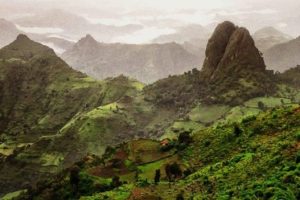The Natural History Museum is a touristic spot found at Arat Killo on the premise of Addis Ababa University. Recently, this writer had dropped in to know firsthand what are there in display. Inquisitive by nature, she talked with the curators. Let her afford readers an insight via her eyes.
* The zoological section
The museum has different classes. The first class is the information room. It has a dives-array of pictures of different animals.
In the second class in display are seen animals that don’t have backbones except the Waliya Ibex, which is an endemic animal found around the Semien mountains. Some of the invertebrates were collected when Red Sea was under Ethiopia’s control. Others like shells, insects etc. were collected from Ethiopia.
The third room houses vertebrates and amphibians like frogs, snakes as well as reptiles.
The fourth and fifth rooms have different mammal’s skins, skulls and horns. The sixth room is comprised of different birds and crocodiles. The animals are preserved by a process called taxidermy which involves a process where dead animals are preserved but look alive. Their inner flesh is removed and replaced by a man- made substance… their eyes are replaced with a resembling glass-like substance.
There are also spectrums of insects found in various parts of Ethiopia that are dried and mounted for portrayal… via a process of preserving their bodies after they die…
Also other preserved animals like wolf, fox, rat, and rabbit are portrayed. The Gelada Baboon and the bale monkey in preserved form are only found in Ethiopia.
There are other carnivorous animals like the Dega Anbessa. Eye catching is an animal called tiring (civet cat) which is helpful in producing perfumes.
The Endemic animals found include Mounyain Nyala, Gelada Baboon, Semien Korkey, Menelik Dekula. Entailed in the museum’s display are also found elephant’s skull, Ivory and bone as well as a leopard.
In the other section there is a room where different animals’ skins are dried and preserved. In this room a preserved cheetah, which runs 120km/hr. while alive, greets the eye.
A skull of a hippopotamus, different species of birds are found in Ethiopia. Some of them are small in size and dwell in the environs of lakes. Some of the birds are carnivorous and others are herbivorous, which feed on grain. These birds are found around lakes like Abiyata.
Among these some are endemic like the Gagano.
A preserved crocodile which is found in areas like Arbaminch also greets the eye.
Zebras like the Grevy Zebra and Burchells Zebra are among the scenes in the museum.
Tikliku Agazen is another mammal that inhabits the Omo Park… it is also found in Tanzania and Kenya.
* The botanic section
There are two plant divisions in this section called the monocote and dycote.
Monocot plants are marked by seeds with a single cotyledon.
The dicots have two embryonic leaves or cotyledons.
Cotyledon is an embryonic leaf in seed-bearing plants, one or more of which are the first leaves to appear from a germinating seed.
The plants are mounted by collecting them from the field and after they have dried they will be ready for showcasing.
On the monograph the plant species will be specified.
The flora is catalogued in a form of a book that incorporates different plants according to their section.
There are indigenous plants in Ethiopia. Also plants that are borrowed or exotic are mounted.
These plants found and collected at different time periods amount to close to 100,000 in number.
BY SENAIT G/HIWOT
The Ethiopian Herald October 5/2023





